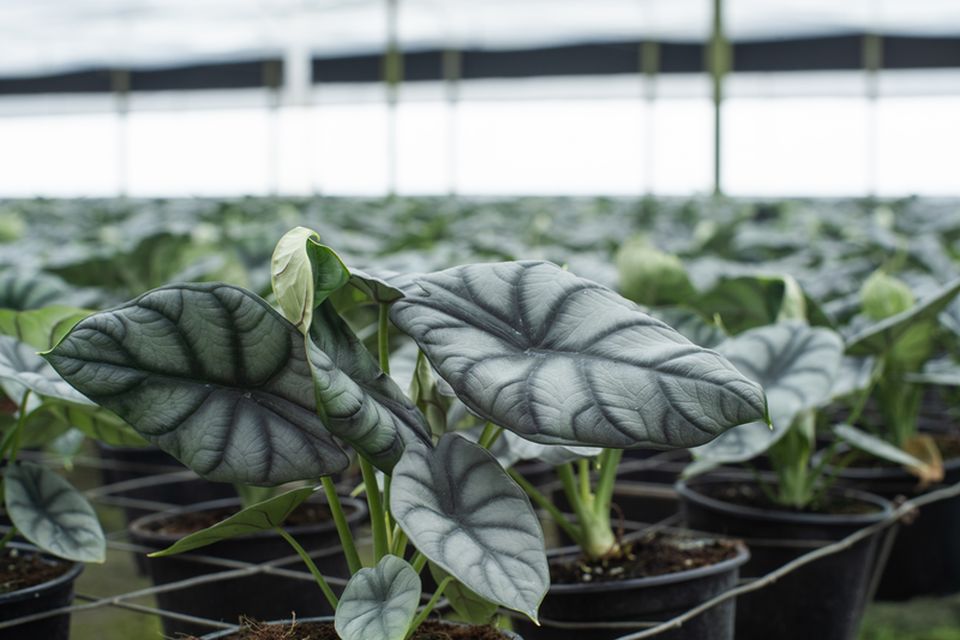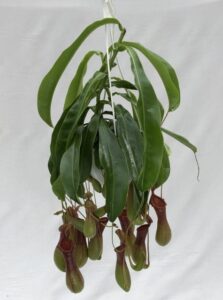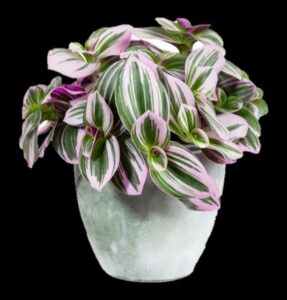Houseplants Update: Consumers to Keep Indoor Jungles with Lower Price Point

Alocasia ‘Silver Dragon’ is a popular offering from Costa Farms due to its silver leaves. Photo: Costa Farms
During the COVID-19 pandemic, consumers were stuck at home. They had the time and money to refresh their living spaces, which led to a boom in houseplants. Plant lovers added more varieties to their collections, and newcomers joined the industry by adding a few plants to show off in their Zoom backgrounds.
As the pandemic wanes, breeders and growers alike are eager to see how consumer demand will change. Justin Hancock, Senior Brand Marketing Manager at Costa Farms, expects there will still be a high demand for houseplants. However, consumers will be looking for lower prices.
“We’re happy to see that just because the pandemic is over, people haven’t abandoned their indoor jungles,” Hancock says. “We’re not sure what it will look like from a spend standpoint yet.”
Kyle Brewer, Sales and Marketing Manager for Deroose Plants, says there is less discretionary income now than during the pandemic. Consumers are able to shop in stores, eat at restaurants, and travel. Inflation also limits how much consumers can spend on plants and other items.
“With inflation and having more options for how to spend your money, people are making different decisions,” Brewer says of consumer spending. “It’s our responsibility to listen to that and still be a part of their everyday life. You have to make your price point attractive, and that coincides with growing different material and growing smaller material to get the product moving.”

Deroose Plants will ramp up production of Nepenthes alata in 2023. It digests insects that land inside of it, making it ideal to control mosquitos around your house. Photo: Deroose Plants
Don’t Price Yourself to the Bottom
Dr. Melinda Knuth, an Assistant Professor of Horticultural Science at North Carolina State University, conducted a survey in 2021 on consumer purchasing trends. She asked participants what prices they are willing to pay for plants, where they buy plants, and how often they buy plants.
Consumers were asked to identify what price is considered cheap, bargain, getting expensive, and too expensive for various plants. For a large palm plant, consumers said $12.80 is “cheap”, $25.40 is a “bargain”, $44 is “getting expensive”, and $65 is “too expensive”.
“A lot of times in our industry, we’re pricing ourselves to the bottom,” Knuth says. “Whoever is selling plants at the cheapest price usually sells the product. That’s not necessarily a sustainable goal that we should have for our industry.”
Survey participants also shared comments on their continuing interest in plants. Knuth asked consumers at what level they would like to continue their gardening hobbies, and all participants indicated at the same rate as they were during the pandemic or they hoped to participate more. This is one of the pandemic hobbies that consumers would like to keep.
“The caveat is that we didn’t have stagflation and other influences that we currently have at the time of the survey,” Knuth says. “At that moment, consumers said they are confident for the future. We generally see that in the industry. We rode the wave of the houseplant craze and that won’t go away.”
Variegation, Easy Care Are Trending
Consumers are following a few hot trends in houseplants and foliage plants. Monstera deliciosa saw a big spike in demand, Hancock says, due to its large, fenestrated foliage and easy care requirements. Costa offered Monstera ‘Thai Constellation’ at Kroger last year, and customers waited in line overnight to buy the plants. Costa also saw a resurgence in pothos varieties. Varieties like Epipremnum (Pothos) ‘Global Green’ are quite popular.
In any foliage plant, Hancock says variegation is trending. Plants with stripes of white, cream, and pink are popular. Consumers also have shown interest in plants with big leaves and silver leaves.
Hancock says he is excited that customers are buying more trailing and climbing houseplant varieties. They are versatile pieces of décor in any home.

Tradescantia ‘Nanouk’ is part of Dümmen Orange’s Welcome to the Jungle program, which is a collection of indoor foliage houseplants. Photo: Dümmen Orange
“If you want to grow it up a moss pole or totem, it gives you a very different look for that same plant,” Hancock says. “It’s a fun way to customize and show off your style.”
Brewer says Deroose Plants is offering varieties that look great and are easy to care for. For example, Alocasia ‘Polly’ and Ginseng Ficus only have to be watered a couple times a week. Appearance also plays a big role in consumer demand. Ginseng Ficus has an exposed root ball that customers enjoy, and alocasia has a glossy finish with veins on the leaves. There is also a surge in demand for smaller products because they are more affordable. Deroose plans to incorporate more 4-inch plants into its product line-up.
The company will ramp up production of Nepenthes alata for 2023, Brewer says. This carnivorous plant holds nectar and digests insects that land inside of it. It is useful to control mosquito populations.
Heather VonAllmen, North American Product Manager for Foliage and Succulents for Dümmen Orange, says after unprecedented 2021 foliage sales growth, the summer of 2022 brought an abrupt sales slow-down.
Dümmen Orange partnered with Dutch grower, Smit, and introduced the new collection, Welcome to the Jungle, at California Spring Trials (CAST) in 2022. This indoor foliage houseplant program includes 50 varieties, such as Peperomia ‘Leap Frog’, Kalanchoe ‘Silver Strand’, and Tradescantia ‘Nanouk’.
Millennials are the driving factor behind trends in succulents and foliage plants. She says millennials are looking for a mission behind their houseplants, such as sustainable harvest practices or community engagement from the grower or retailer.
Despite the slow-down, VonAllmen says Welcome to the Jungle has received a lot of interest at shows like the Global Produce & Floral Show, and there will be 15 additional varieties introduced at the Tropical Plant International Expo from Jan. 18-20 in Tampa, FL.









